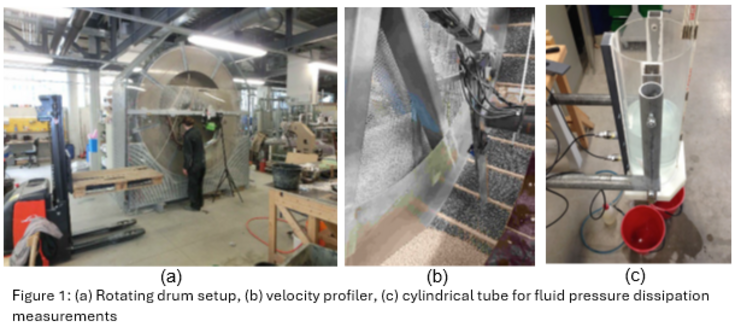Flow behavior of experimental debris flows
SUPERVISOR: Roland KAITNA
PROJECT ASSIGNED TO: Felix Maximilian KLEIN
The flow behavior of debris flows is governed by the internal deformation of water–sediment mixtures, yet the underlying rheology remains insufficiently understood despite extensive field observations and various modelling approaches. Existing models—from empirical runout predictions to process-based and physically motivated continuum formulations—rely on assumptions regarding grain-size distribution, pore-fluid pressure, or friction that are often only weakly constrained by experiments. Laboratory studies that directly measure internal deformation, shear processes, and pore-pressure evolution are therefore essential for calibrating, validating, or falsifying these assumptions (Delannay et al., 2017).
This PhD project, carried out within the FWF-funded Behave project, systematically investigates how grain-size distribution, fine-material content, and the uniformity of the coarse fraction influence internal deformation, pore-fluid pressure, and overall flow resistance in experimental debris flows. Using a rotating drum with a diameter of ~2.5m (Kaitna et al., 2007; Schneider et al., 2011), we will test mixtures with varying grain-size characteristics while measuring velocity profiles, basal stresses, and pore pressures at high temporal resolution. Particular attention is given to pore-pressure feedbacks that may promote liquefaction (Iverson, 1997; Kaitna et al., 2016, 2014; McArdell et al., 2007). Complementary pressure-dissipation experiments (Major, 2000) will support the interpretation of dynamic observations. Additionally, a small-scale rheometer will be used to characterize the rheology of the fluid phase of the mixture.
Central research questions:
- How does grain-size distribution control internal deformation and pore-pressure evolution in debris-flow mixtures, and what does this imply for the suitability of existing modeling approaches?
- Can we identify different flow regimes and explain transitions based on dimensionless numbers?
- Can we link the observations from the experiments to field observations of natural debris flows?
The Behave project also involves another PhD student who focuses on the flow behavior of natural debris flows. The third research question aims at synthesizing these observations with the findings from the laboratory measurements.

Delannay, R., Valance, A., Mangeney, A., Roche, O., Richard, P., 2017. Granular and particle-laden flows: from laboratory experiments to field observations. J. Phys. Appl. Phys. 50, 053001. doi.org/10.1088/1361-6463/50/5/053001
Iverson, R.M., 1997. The physics of debris flows. Rev. Geophys. 35, 245–296. doi.org/10.1029/97RG00426
Kaitna, R., Dietrich, W.E., Hsu, L., 2014. Surface slopes, velocity profiles and fluid pressure in coarse-grained debris flows saturated with water and mud. J. Fluid Mech. 741, 377–403. doi.org/10.1017/jfm.2013.675
Kaitna, R., Palucis, M.C., Yohannes, B., Hill, K.M., Dietrich, W.E., 2016. Effects of coarse grain size distribution and fine particle content on pore fluid pressure and shear behavior in experimental debris flows. J. Geophys. Res. Earth Surf. 121, 415–441. doi.org/10.1002/2015JF003725
Kaitna, R., Rickenmann, D., Schatzmann, M., 2007. Experimental study on rheologic behaviour of debris flow material. Acta Geotech. 2, 71–85. doi.org/10.1007/s11440-007-0026-z
Major, J.J., 2000. Gravity-Driven Consolidation of Granular Slurries: Implications for Debris-Flow Deposition and Deposit Characteristics. J. Sediment. Res. 70, 64–83. doi.org/10.1306/2DC408FF-0E47-11D7-8643000102C1865D
McArdell, B.W., Bartelt, P., Kowalski, J., 2007. Field observations of basal forces and fluid pore pressure in a debris flow. Geophys. Res. Lett. 34. doi.org/10.1029/2006GL029183
Schneider, D., Kaitna, R., Dietrich, W.E., Hsu, L., Huggel, C., McArdell, B.W., 2011. Frictional behavior of granular gravel–ice mixtures in vertically rotating drum experiments and implications for rock–ice avalanches. Cold Reg. Sci. Technol. 69, 70–90. doi.org/10.1016/j.coldregions.2011.07.001
